Regardless of whether you are a beginner or a professional guitar player with decades of experience under your belt, it’s hard to ignore the “wow” factor once you see a premium high end acoustic guitar. But, once you get past the initial astonishment and dig a little deeper, you see the price tag and then you start wondering whether they are actually worth the money.
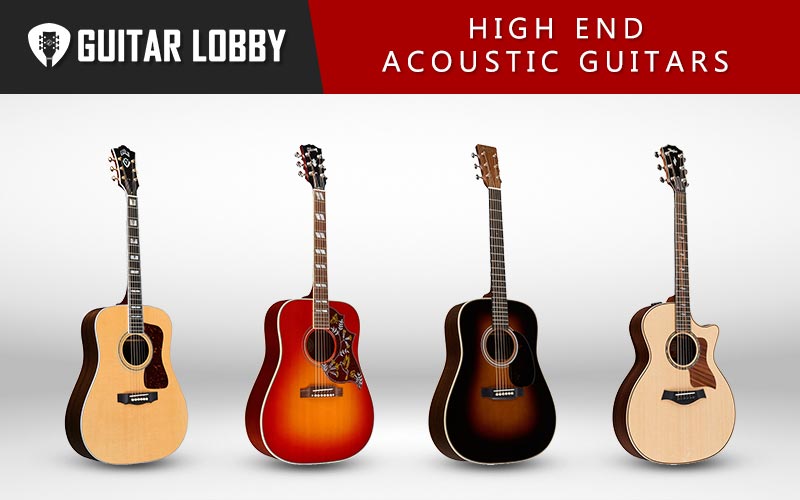
When compared to their affordable mid-range counterparts, premium acoustic guitars are not only superior in terms of sound and playability, but also a whole range of other parameters, such as build quality, tonewoods, quality of the hardware, as well as looks.
So, which acoustic guitars are actually considered to be high end or premium? Well, it’s hard to pinpoint the exact number, but there is a significant rise in overall quality and characteristics once you get past the $1500 to $2000 price tag.
I’ll start this article by jumping into reviews on some of my favorite high end guitars, but if you want to learn more about them before reading reviews check out our acoustic guitar information guide at the bottom of the page here.
| Name of Product | Image of Product | Description | Price Range | Full Review |
|---|---|---|---|---|
| 1. Martin D-41 Dreadnought Acoustic Guitar (Best Overall) | 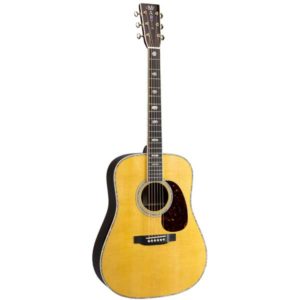 | Body style: Dreadnought Top: Solid Sitka Spruce | $5000 | Read Full Review Below |
| 2. Taylor Guitars 814ce V-Class Grand Auditorium Acoustic-Electric Guitar (Best Under $4000) | 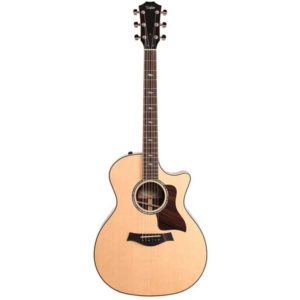 | Body Style: Grand Auditorium with Venetian Cutaway Top: Solid Sitka Spruce | $3700 | Read Full Review Below |
| 3. Martin D-28 Dreadnought Acoustic Guitar (Best Under $3000) | 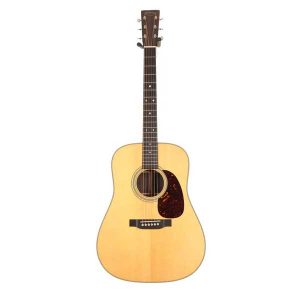 | Body Style: Dreadnought Top: Solid Sitka Spruce | $3000 | Read Full Review Below |
| 4. Martin 15 Series D-15M Dreadnought Acoustic Guitar (Best Under $2000) | 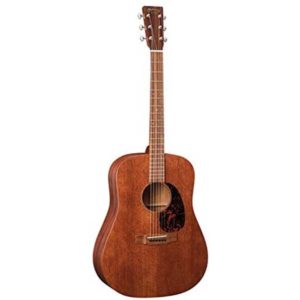 | Body Style: Dreadnought Top: Solid Mahogany | $1400 | Read Full Review Below |
| 5. Gibson Hummingbird Acoustic-Electric Guitar Vintage Cherry Sunburst | 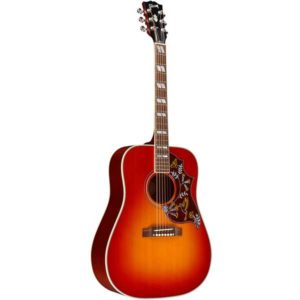 | Body Style: Square Shoulder Dreadnought Top: Solid Sitka Spruce | $4000 | Read Full Review Below |
| 6. Taylor K14ce V-Class Builder’s Edition Grand Auditorium Acoustic-Electric Guitar Kona Burst | 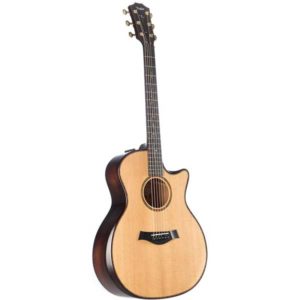 | Body Style: Grand Auditorium with Venetian Cutaway Top: Solid Sitka Spruce | $5500 | Read Full Review Below |
| 7. Guild USA D-55 Traditional Dreadnought Acoustic Guitar Natural | 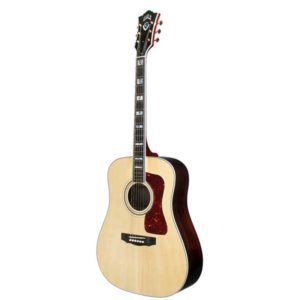 | Body Style: Dreadnought Top: Solid Sitka Spruce | $3900 | Read Full Review Below |
| 8. Gibson J-45 Standard Acoustic-Electric Guitar Vintage Sunburst | 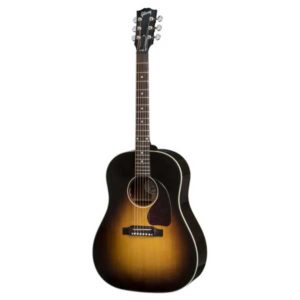 | Body Style: Slope Shoulder Dreadnought Top: Solid Sitka Spruce | $2850 | Read Full Review Below |
| 9. Gibson SJ-200 Standard Acoustic-Electric Guitar Vintage Sunburst | 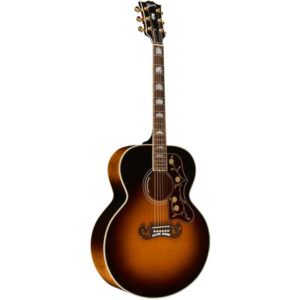 | Body Style: Super Jumbo Top: Sitka Spruce | $5000 | Read Full Review Below |
| 10. Yamaha A5R ARE Folk Acoustic-Electric Guitar Vintage Natural | 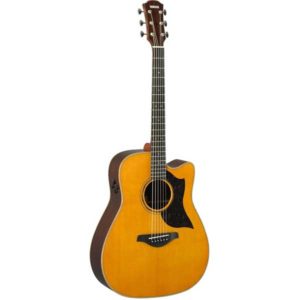 | Body Style: Dreadnought with Cutaway Top: Solid Sitka Spruce | $1600 | Read Full Review Below |
| 11. Takamine Pro Series P4DC Dreadnought Cutaway Acoustic-Electric Guitar | 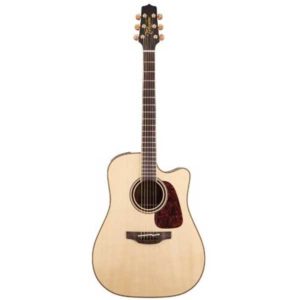 | Body Style: Dreadnought with Cutaway Top: Solid Sitka Spruce | $1400 | Read Full Review Below |
| 12. Taylor Guitars 714ce V-Class Grand Auditorium Acoustic-Electric Guitar | 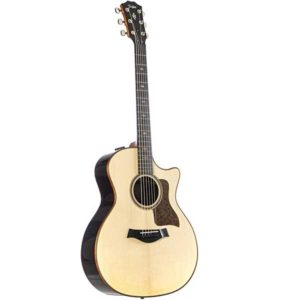 | Body Style: Grand Auditorium with Venetian Cutaway Top: Solid Lutz Spruce | $3200 | Read Full Review Below |
| 13. Martin Authentic Series 1933 OM-18 VTS Orchestra Model Acoustic Guitar Natural | 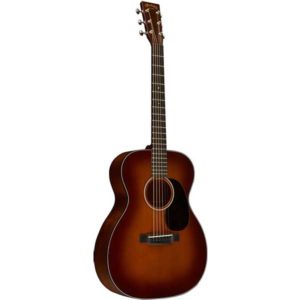 | Body Style: Orchestra Model Top: VTS Solid Adirondack Spruce | $5300 | Read Full Review Below |
| 14. Martin HD-28 Standard Dreadnought Acoustic Guitar Aged Toner | 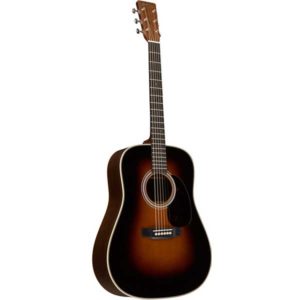 | Body Style: Dreadnought Top: Solid Sitka Spruce | $3400 | Read Full Review Below |
| 15. Taylor 414ce-R V-Class Grand Auditorium Acoustic-Electric Guitar Natural | 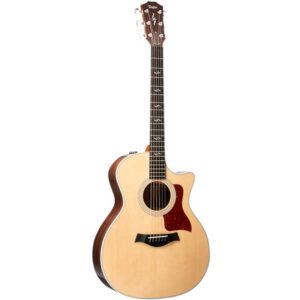 | Body Style: Grand Auditorium with Venetian Cutaway Top: Solid Sitka Spruce | $2800 | Read Full Review Below |
| 16. Taylor Guitars 914ce V-Class Grand Auditorium Acoustic-Electric Guitar | 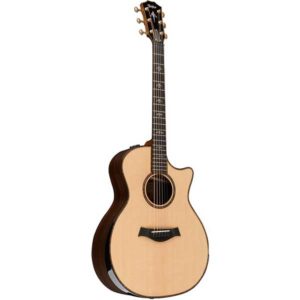 | Body Style: Grand Auditorium with Venetian Cutaway Top: Solid Sitka Spruce | $5500 | Read Full Review Below |
| 17. Martin D-18E Dreadnought Acoustic Electric Guitar | 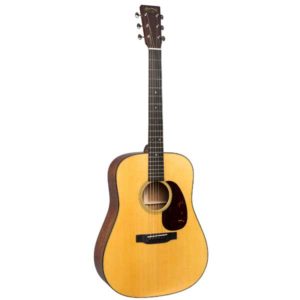 | Body Style: Dreadnought Top: Solid Sitka Spruce | $4200 | Read Full Review Below |
Here Are the Best High End Acoustic Guitars
1. Martin D-41 Dreadnought Acoustic Guitar (Best Overall)
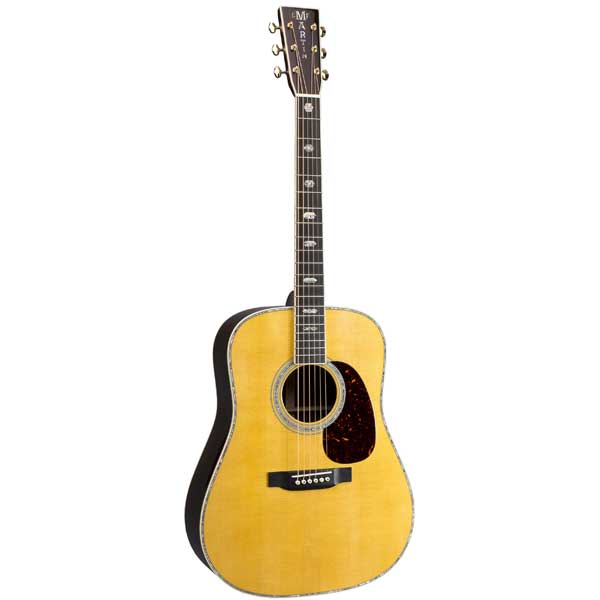
| Estimated Price | $5000 |
| Body Style | Dreadnought |
| Top | Solid Sitka Spruce |
| Back and Sides | Solid East Indian Rosewood |
| Neck | Mahogany |
| Finish | Gloss Nitrocellulose with Aging Toner |
| Body Bracing | Scalloped Forward Shifted X-Bracing |
| Fret Count | 20 |
| Country of Origin | USA |
My Review: Martin has done a really good job over the years of reimagining its legendary guitars, and this D-41 is just about as good as it gets. In fact, this is just about the best guitar you can buy today, apart from shelling out five figures for an actual vintage version. Unlike most Martin guitars from the 40 series, this one is pretty understated in its looks, although still incredibly elegant and classy, with abalone inlays for the fretboard and soundhole rosette. We also love the rosewood sides and back with white binding. The neck is mahogany, with a 1.75-inch nut width, which makes this guitar stunningly comfortable and easy to play.
As for the sound, it is absolutely amazing, whether you are strumming loud chords or doing some gentle fingerpicking. Deep and rich bass tones, bright and sparkling trebles, full midrange, you name it. The D-41 does it better than any other guitar out there. And it will only sound better with age. The scalloped forward-shifted bracing is really doing its job here. Just spending 15 minutes with this acoustic guitar is enough to make everything else you’ve ever played pale in comparison.
Who Will Use This Most: Professional guitar players, recording artists, and studio musicians. Martin D-41 belongs in the collection of every musician and guitar aficionado that can afford it. It’s the sort of guitar that gets passed onto other generations, only gaining in value and tone.
Bottom Line: The Martin D-41 could be the poster child for the phrase “buy once, cry once” and the price tag is completely justified. The only guitars that can go up against it are actual vintage Martins, which is about as good of a compliment you will ever come across. Simply put, this is the only acoustic guitar you will ever need in your life, so you might as well start saving up for one now.

2. Taylor Guitars 814ce Acoustic-Electric Guitar (Best Under $4000)
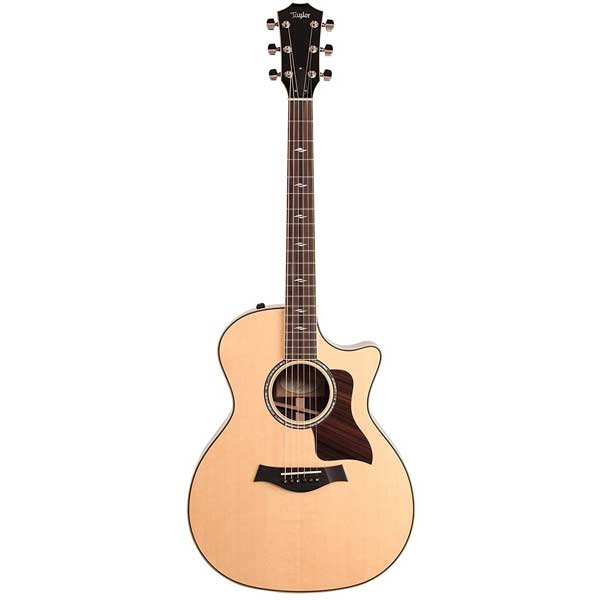
| Estimated Price | $3700 |
| Body Style | Grand Auditorium with Venetian Cutaway |
| Top | Solid Sitka Spruce |
| Back and Sides | Solid Indian Rosewood |
| Neck | Tropical Mahogany |
| Finish | Gloss 3.5 |
| Body Bracing | V-Class with Relief Rout |
| Fret Count | 20 |
| Country of Origin | USA |
My Review: Since we are speaking about the only acoustic guitars you will ever need in your life, we have to mention the Taylor 814ce. This could have easily been our first pick. The 814ce boasts that signature bright, loud Taylor sound has become synonymous with, with crisp and clear treble and midrange tones, complemented by a warm low end. Whether you are playing solos or just strumming, this acoustic guitar is nothing short of sublime, and it’s really comfortable to play to, thanks to low action, Venetian cutaway which allows you to access the frets more easily, and a neck that fits perfectly in your hands.
Like all guitars in the 800 Series, the 814ce has a top which is made out of solid Sitka spruce, with back and sides made from solid Indian rosewood. They’ve also really paid attention to how this guitar looks, as well, with an abalone rosette and mother-of-pearl fingerboard inlays which give this guitar a true premium shine. On the inside, the 814ce has V-Class bracing, which really makes a difference, especially in comparison with other, similarly priced models. The guitar sounds louder and has incredible sustain, even for a high end guitar. You can also plug this into an amp since it features the Expression System 2, which has three piezo sensors in order to capture the sound in all of its glory. And glorious it really is.
Who Will Use This Most: Although not as expensive as Martin D-41, the Taylor 814ce is out of reach for most guitar players. This means it will mostly be used by professional artists that are able to afford it. It’s also ideal for live performance, especially for acoustic rock and country, since its bright, loud sound cuts through any kind of mix.
Bottom Line: The Taylor 814ce acoustic guitar is simply breathtaking in terms of sound, looks, build quality, and attention to detail. It works in just about any setting, and for the price, there is no better guitar.

3. Martin D-28 Dreadnought (Best Under $3000)
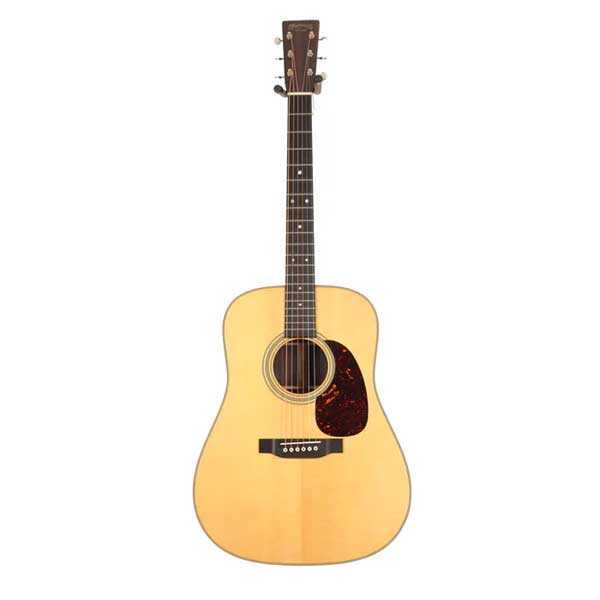
| Estimated Price | $3000 |
| Body Style | Dreadnought |
| Top | Solid Sitka Spruce |
| Back and Sides | Solid East Indian Rosewood Body |
| Neck | Select Hardwood |
| Finish | Gloss |
| Body Bracing | Non-Scalloped Forward Shifted X-Bracing |
| Fret Count | 20 |
| Country of Origin | USA |
My Review: No list of all-time great acoustic guitars would be complete without the Martin D-28, which is simply iconic, there is no other word for it. It was introduced back in 1931 and has been played by the likes of Jimmy Page, Johnny Cash, and Eric Clapton. This particular model is a re-imagining of the original D-28, and while that’s usually a recipe for disaster, Martin has done a great job of improving upon the original, just like they did with the D-41. The guitar features a solid Sitka spruce top, and solid East Indian rosewood back and sides.
One of the things that were updated on the D-28 is the bracing pattern, and now it features a forward-shifted X-bracing, which means this model has a better bass response than the original. However, the sound is very well balanced, with crisp highs and clear midrange tones. The D-28 also features a new neck design for more comfortable playing. In terms of looks, Martin has gone for the vintage-style aesthetic, which is understated and elegant. One of the things that really stands out on the D-28 is the piano-like sustain, which is down not just to the dreadnought body shape, but also the updated bracing pattern. The original is one of the all-time great guitars, and the updated Martin D-28 belongs in the same category. It’s nothing short of sublime.
Who Will Use This Most: Touring musicians and studio professionals alike. The D-28’s dreadnought body shape makes it ideal for any kind of music style which involves chords and loud strumming. However, it’s balanced sound means it’s also great for softer fingerpicking as well. Even though it’s cheaper than our first two picks, it’s right up there with them in every category.
Bottom Line: The Martin D-28 is everything you would want in an acoustic guitar, and then some. Martin has really done an awesome job reimagining and updating their legendary models, and we can safely say that it has outdone itself with the D-28. If you’re looking for a great high end acoustic guitar and your budget is around $3000, this is a great option.
Related Article: The 14 Best American Made Guitars

4. Martin 15 Series D-15M (Best Under $2000)
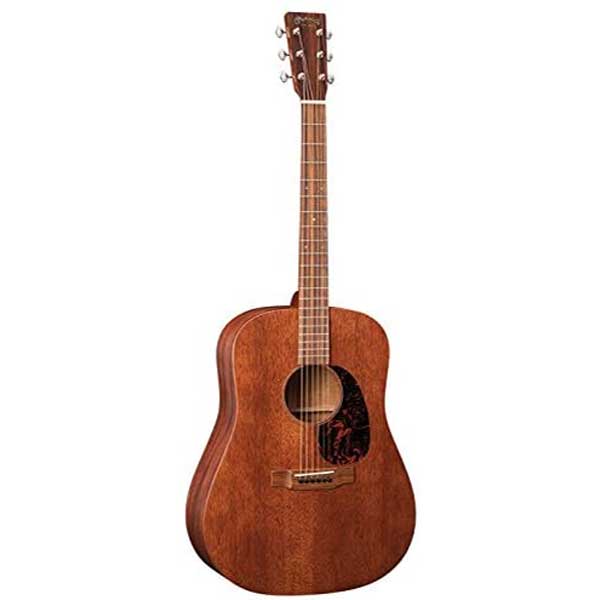
| Estimated Price | $1400 |
| Body Style | Dreadnought |
| Top | Solid Mahogany |
| Back and Sides | Solid Mahogany |
| Neck | Mahogany |
| Finish | Satin Nitrocellulose |
| Body Bracing | X-Bracing |
| Fret Count | 20 |
| Country of Origin | USA |
My Review: How good are high end acoustic guitars on the low-end of the price range? Judging by the Martin D-15M, they are excellent. And yes, this is already the third Martin on our list, which just goes to show how good they are making acoustic guitars. Along with Taylor, Martin is simply in a league of its own. The D-15M, unlike some of the other guitars on this list, is built with a no-frills approach in mind. You won’t find any fancy binding or inlays. However, you will find a solid, all-mahogany body which is amazing. It has that signature deep mahogany sound, without sounding too muddy or indistinctive. Adding to the overall vintage look are the satin finish and open-gear tuners.
The D-15M might not look as expensive as some of the company’s top-tier models, but what Martin has done with this guitar is put every single penny where it counts: into the sound and build quality of the guitar. It also features a bone nut and saddle, and as for the playing itself, you should find its low oval neck really comfortable. It costs significantly less than most of the guitars on this list, yet you still get an acoustic guitar which is all-solid and sounds like it costs twice as much. $1300 is not cheap by any means, but it’s at least something you can eventually save up for. And the Martin D-15M is worth every penny, especially if you like the looks and the sound of mahogany. We wholeheartedly recommend it.
Who Will Use This Most: If there was ever a guitar that was ideal for a singer-songwriter, the D-15 is it. It’s also perfect for playing some of the darker blues-based stuff, due to all-mahogany construction, and you would be hard-pressed to find a professional recording artist that wouldn’t add this guitar to their collection, as well.
Bottom Line: We love everything about the Martin D-15. It’s no-frills looks, rich mahogany sound, vintage styling, as well as the price. For the money, this is easily one of the best high end acoustic guitars out there!
Related Article: Recommended Guitar Tuners (All Types)

5. Gibson Hummingbird Acoustic-Electric Guitar
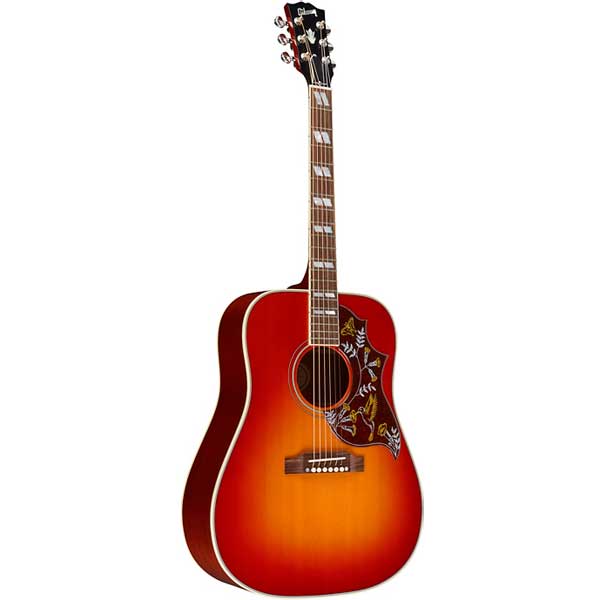
| Estimated Price | $4000 |
| Body Style | Square Shoulder Dreadnought |
| Top | Solid Sitka Spruce |
| Back and Sides | Solid Mahogany |
| Neck | Mahogany |
| Finish | Nitrocellulose Vintage Cherry Sunburst |
| Body Bracing | Traditional Hand-Scalloped X-Bracing |
| Fret Count | 20 |
| Country of Origin | USA |
My Review: This is hands-down one of the most beautiful acoustic guitars you can buy today, and is arguably the most recognizable design ever made by Gibson. The Gibson Hummingbird guitar is more than likely to catch your eye with its stunning pickguard that’s decorated with hummingbird and flowers, especially when combined with the Vintage Cherry Sunburst finish. In case you are not a fan of this type of finish, you can get the Humminbird with a natural finish for about $150 less, which still features the same pickguard. It’s an incredibly easy guitar to play, and almost impossible to put down once you strum those first few chords.
The body is made up of solid Sitka spruce top and solid mahogany back and sides. This means that you get a bright, resonant high end from the Sitka spruce, which is then balanced by the mahogany. We also like the fact that the secondary strap lock is attached to the body of the guitar at the 14th fret, thanks to the compound dovetail. This makes for a much better feel when you play standing up, as well as more freedom in terms of movement and fretboard control. You can also plug the Humming into an amp, thanks to the built-in LR Baggs elements VTC system. All things considered, this is one of the best guitars Gibson is making today.
Who Will Use This Most: Given the price tag, the Hummingbird is aimed squarely at professional musicians and recording artists. It has been used both live and inside the studio by the likes of Brian May, Thom Yorke, The Rolling Stone, Eric Clapton, and the late Chris Cornell. That pretty much says it all about this guitar.
Bottom Line: The Gibson Hummingbird acoustic guitar is an epic instrument, both in terms of looks and sound. It’s a flawless guitar that adapts to any style of playing, which is why it’s so beloved among the rock, blues, and country artists alike.

6. Taylor K14ce V-Class Builder’s Edition
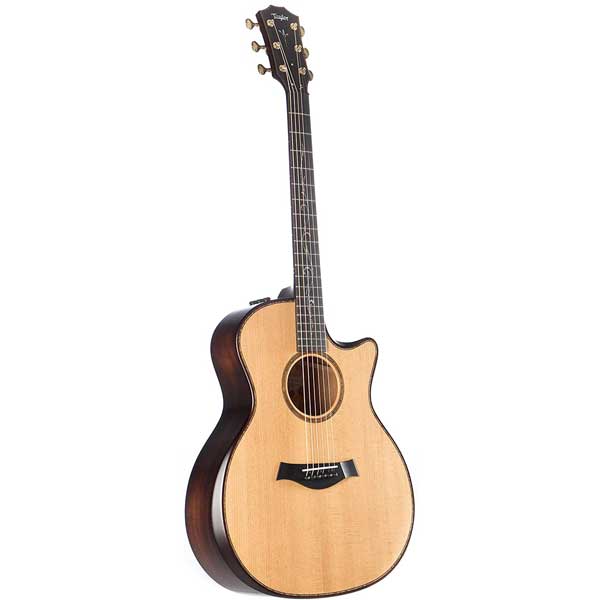
| Estimated Price | $5500 |
| Body Style | Grand Auditorium with Venetian Cutaway |
| Top | Solid Sitka Spruce |
| Back and Sides | Solid Figured Hawaian Koa |
| Neck | Tropical Mahogany |
| Finish | ‘Silent’ Satin with Kona Burst |
| Body Bracing | Patented V-Class Bracing |
| Fret Count | 20 |
| Country of Origin | USA |
My Review: The Taylor K14ce takes everything that great about Taylor guitars, and then cranks it up a few notches. Belonging to the Builder’s Edition series, the K14ce combines the tried-and-tested sound of the best Taylor guitars, and brings along a couple of clever innovations. The top is made from Sitka spruce, which has undergone a process of torrefaction, which involves roasting of the wood in order to achieve better response and tonal characteristics. It mimics the same process which causes the guitar to sound better with age. The back and sides are made from Koa, which not only looks great, but also has tonal qualities which are similar to mahogany, but with a slightly brighter top end, which makes this guitar really articulate and resonant.
The body of the K14ce also has a few tricks up its sleeve, with its bevelled armrest, bevelled cutaway, and neck contouring. This provides a level of playing comfort unlike anything we have ever seen on a guitar, and we hope that this approach will be adopted by more manufacturers. The Taylor K14ce looks great too, although that is something we have come to expect from the brand. But, unlike the high-gloss sheen of most high end Taylor guitars, this one has a ‘silent’ satin finish with Kona burst, which is refreshingly discreet. The K14ce also features the revolutionary V-bracing, which gives the guitar more sustain and volume, but with pure notes that don’t cancel each out, no matter how loud you play.
Who Will Use This Most: Professional artists all across the board, especially when you take into account the price tag. It’s just about perfect for live performances, because of its bevelled armrest and cutaways, which make long gigs much more pleasant.
Bottom Line: The Taylor K14ce is one of the best acoustic guitars you can buy today, hands down. Not only does it have that classic Taylor sound, but it also makes a few improvements in terms of comfort, playability, and response. Highly recommended.
Related Popular Article: Our Favorite Guitar Straps

7. Guild USA D-55 Traditional Dreadnought
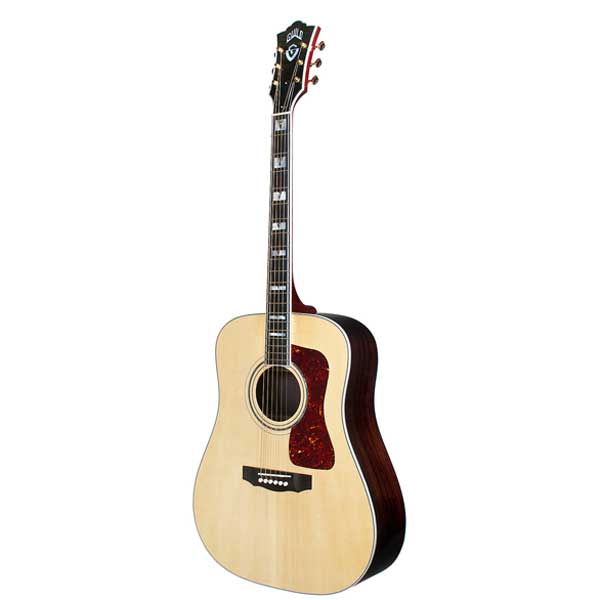
| Estimated Price | $3900 |
| Body Style | Dreadnought |
| Top | Solid Sitka Spruce |
| Back and Sides | Solid Indian Rosewood |
| Neck | Mahogany/Walnut |
| Finish | Gloss |
| Body Bracing | Scalloped Adirondack Spruce Bracing |
| Fret Count | 20 |
| Country of Origin | USA |
My Review: if you are looking for the ultimate dreadnought guitar, the Guild Traditional D-55 will be right up your alley. It’s similar to some of the dreadnought Martins we have on this list, with rich, deep bass response, and sparking high ends. As such, the Guild D-55 is perfect for those that prefer lour strumming of the chord over gentle fingerpicking, even though it’s just as good in that department too. The D-55 has a really thin neck D profile, which is why strummers will absolutely love it. And it sports a stunningly low action, which makes the D-55 one of best guitars out there in terms of playability.
Internal bracing is made from scalloped Adirondack spruce, which is very light and stiff, and resonant at the same time. Like all instruments in the Guild’s Traditional series, this guitar also features intricate details, such as detailed binding and generous use of abalone and mother-of-pearl. There is also gold hardware, and an ebony fretboard and bridge. In terms of craftsmanship and materials used to build it, the D-55 is absolutely superb. It plays great and it sounds great.
Who Will Use This Most: Although the D-55 is great for all music styles, even those which involve gentle fingerpicking, it will feel right at home among rock and country musicians. And it will especially excel on stage, because it’s sturdy in addition to being beautifully crafted.
Bottom Line: The Guild D-55 is a classy, loud, and extremely playable guitar which also happens to feature superb build quality. If you are a fan of thin necks and strumming, this is the guitar for you.

8. Gibson J-45 Standard Acoustic-Electric Guitar
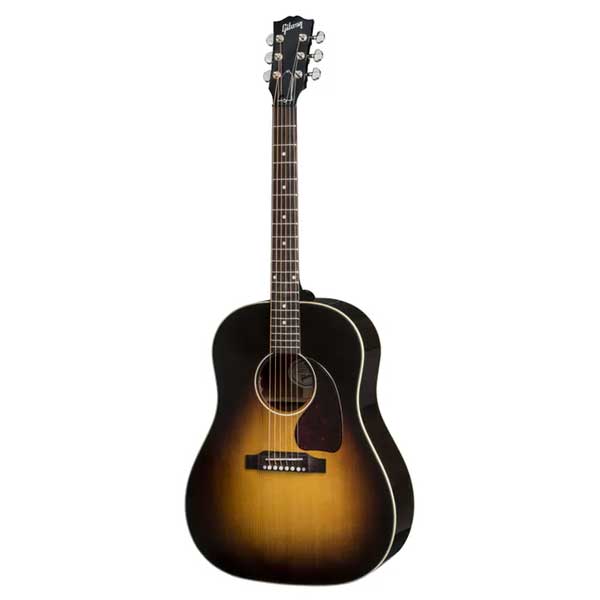
| Estimated Price | $2850 |
| Body Style | Slope Shoulder Dreadnought |
| Top | Solid Sitka Spruce |
| Back and Sides | Solid Mahogany |
| Neck | Mahogany |
| Finish | Gloss with Vintage Sunburst |
| Body Bracing | Traditional Hand-Scalloped X-Bracing |
| Fret Count | 20 |
| Country of Origin | USA |
My Review: Gibson J-45 is one of the true acoustic guitar classics, and one of the best acoustics Gibson has to offer. The top is made from solid Sitka spruce top, which results in a bright, resonant high end spruce tops are known for. However, the J-45 sounds incredible across the entire range, thanks to solid mahogany back and sides, which provide the rich, deep bass noted, and a balanced midrange. The traditional hand-scalloped X-bracing makes this guitar resonate beautifully. It’s easy on the eyes, as well. Although available in several different glossy finishes, we especially love the rich Vintage Sunburst.
Because it has a built-in preamp system, the J-45 is also ideal for live performances, although it’s tonal qualities will also shine in a studio environment. Among Gibson connoisseurs, the J-45 is also known as the “workhorse”, because of its build quality and durability. If your playing involves a lot of strumming or if you like an acoustic guitar that can handle a heavier attack on the strings, the Gibson J-45 is just what you are looking for, provided that you can afford it.
Who Will Use This Most: Given how tough and durable it is, the J-45 will be the acoustic guitar of choice for many touring musicians, although its well-balanced tone makes it good for a studio instrument as well. Great for rock, country, blues, as well as any other type of music where strumming is common.
Bottom Line: Despite being a premium acoustic guitar, the J-45 is not some fragile instrument. It can handle pretty much anything you can throw at it, both in terms of wear and tear, as well as music style.

9. Gibson SJ-200 Standard Acoustic-Electric Guitar
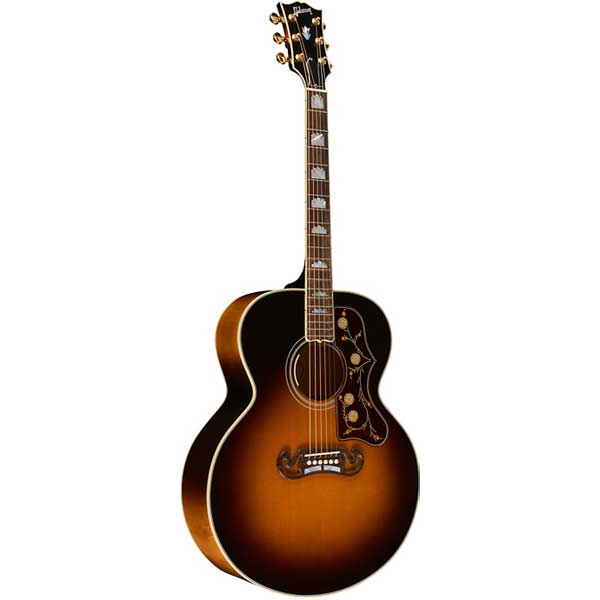
| Estimated Price | $5000 |
| Body Style | Super Jumbo |
| Top | Sitka Spruce |
| Back and Sides | Maple |
| Neck | Maple |
| Finish | Gloss Nitrocellulose with Vintage Sunburst |
| Body Bracing | Traditional Hand-Scalloped X-Bracing |
| Fret Count | 20 |
| Country of Origin | USA |
My Review: Which acoustic guitar would you buy if money was no object? The Gibson SJ-200 is such a guitar and then some. It is very likely that you’ve heard it a million times already since it has been played live and inside the studio by the likes of Bob Dylan, George Harrison, and Pete Townshend. You would be hard-pressed to find an acoustic that is more ingrained into the history of rock’n’roll than the SJ-200. However, such a pedigree comes at a price. The SJ-200 costs nearly $4,500, but for that kind of money, you get absolute perfection in terms of sound, build quality, as well as looks, because it’s a thing of beauty.
It has a Super Jumbo body, which means the sound it produces is huge, with rich bass tones, rich midrange, and just a tad of twang on the high end. Because it’s so massive, it weighs 10 pounds, which is heavier than most electric guitars, let alone acoustics. It’s extremely playable, as well, with bevelled frets, low action, and a D shape neck. It’s hard to imagine a guitar that is more perfect for rock, country, or folk music. Every single detail on this guitar is premium, from the binding, mother-of-pearl inlays on the fretboard, the signature “moustache” bridge, beautiful pickguard, back stripe, gold-plated open-gear tuners… The list just goes on and on, and we could talk about this guitar for days. That’s how impressive it is.
Who Will Use This Most: Those who can afford the insane price tag, along with the cost of maintenance that comes with such an instrument. If you are a professional rock, country, or folk musician, this is the guitar to buy, but you already know that.
Bottom Line: The Gibson SJ-200 is a superb, flawless acoustic guitar that, despite the price, is worth every penny. Not only are you getting the absolute best in terms of, well, everything, but you are also buying a piece of music history. This is certainly one of the kings of expensive acoustic guitars.
Popular Article: Our Favorite Acoustic Guitars Under 1000 Dollars

10. Yamaha A5R ARE Folk Acoustic-Electric Guitar
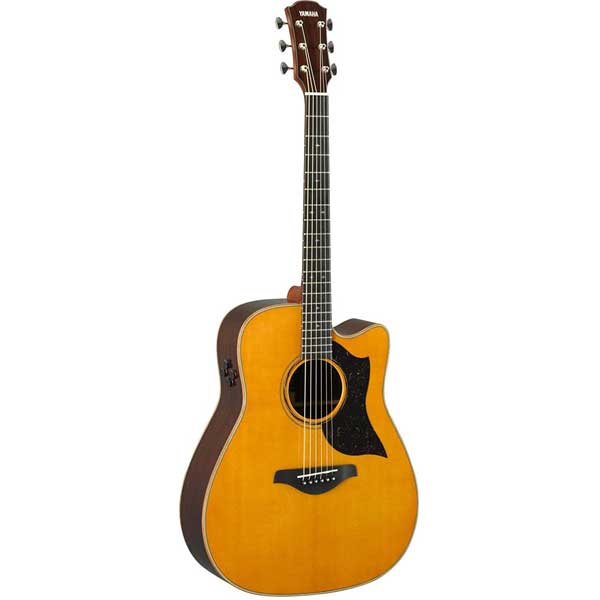
| Estimated Price | $1600 |
| Body Style | Dreadnought with Cutaway |
| Top | Solid Sitka Spruce |
| Back and Sides | Solid Rosewood |
| Neck | African Mahogany |
| Finish | Gloss |
| Body Bracing | Scalloped |
| Fret Count | 20 |
| Country of Origin | Japan |
My Review: The Yamaha A5R ARE is a premium model which has been built with absolute quality in mind. Despite that, it won’t completely destroy you financially, since it’s among the most “affordable” high-end guitars. The ARE in its name stands for Acoustic Resonance Enhancement, which is Yamaha’s version of the torrefaction, which is a speed-up process of wood ageing. The A5R features a solid Sitka spruce top which has a rich gold color, which indicates that the ARE process also affected the looks of the guitar, not just the sound. These guitars are designed to be used live, not just because of the build quality, but also because it features Yamaha’s very own SRT2 preamp system.
Another important requirement for live stage performances is playability, and the A5R has that in spades. It has ‘hand-rolled’ fretboard edges, which make the guitar extremely comfortable to play and give it a feel of a guitar that has already been played. Inside the body, there is scalloped bracing, which should make the guitar louder, especially in low-mid frequencies. It’s a fantastic instrument for the price.
Who Will Use This Most: Since the A5R features an advanced preamp system, it will be a guitar of choice for touring musicians who like their acoustic sounding just as good plugged in as they do unplugged.
Bottom Line: All things considered, the Yamaha A5R is a great “affordable” high-end guitar, which sports some of the stuff that can be seen on more expensive guitars, such as the top that’s been thermally treated for better sound. You won’t regret buying one.

11. Takamine Pro Series P4DC Dreadnought Cutaway Acoustic-Electric Guitar
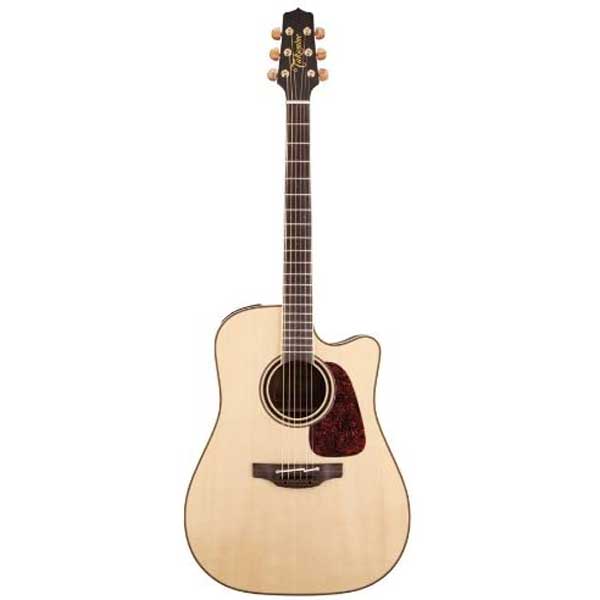
| Estimated Price | $1400 |
| Body Style | Dreadnought with Cutaway |
| Top | Solid Sitka Spruce |
| Back and Sides | Solid Sapele |
| Neck | Mahogany |
| Finish | Gloss |
| Body Bracing | Scalloped X-Bracing |
| Fret Count | 20 |
| Country of Origin | Japan |
My Review: Takamine is a brand that is known for its well-made guitars, but they are not mentioned all that often when it comes to high-end acoustic guitars. Well, the P4DC makes a pretty strong case that Takamine belongs in the premium crowd. It features a dreadnought body, which means you can expect a loud, resonant guitar that is ideal for strumming. Also, there is a cutaway, which gives you better access to upper frets. As for the top of the body, it is made out of solid Sitka spruce with scalloped X-bracing, so you can expect a pretty bright and clear sound. The back and sides are made from solid Sapele, which has similar tonal qualities as mahogany, but which is still somewhat brighter.
Even though the Takamine PD4C is at the lower end of our list of high-end guitars in terms of price, it is incredibly well made, and the attention to detail is something we would expect from much pricier models. There is ivory binding, a lovely pattern pickguard, and concentric rings around the soundhole rosette. This guitar is also ideal for the stage because it comes with its own CTP-3 CoolTube preamp system.
Who Will Use This Most: Musicians who are looking for a great-sounding, yet robust instrument can plug in live at any time. Singer-songwriters will also find much to like here.
Bottom Line: If you are looking for a high-end acoustic guitar that you can play live in any kind of setting, but whose price isn’t astronomical, the Takamine PD4C is the right instrument for you. Not only does it look great, but it also sounds and feels like a more expensive guitar.

12. Taylor Guitars 714ce V-Class Grand Auditorium Acoustic-Electric Guitar
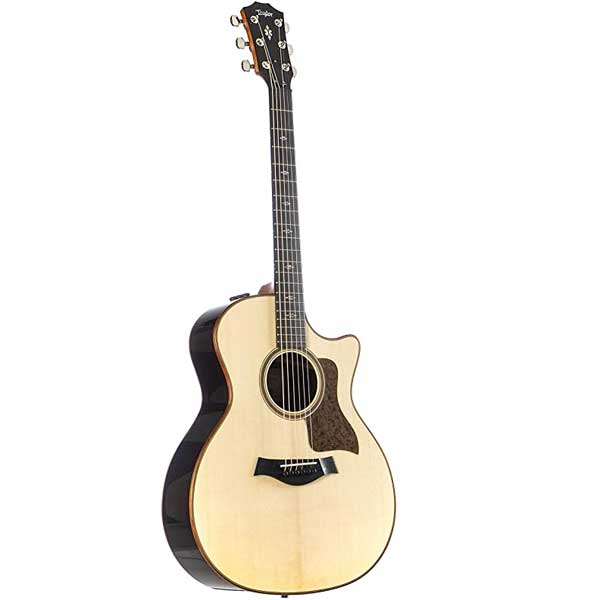
| Estimated Price | $3,200 |
| Body Style | Grand Auditorium with Venetian Cutaway |
| Top | Solid Lutz Spruce |
| Back and Sides | Solid Indian Rosewood |
| Neck | Tropical Mahogany |
| Finish | Gloss |
| Body Bracing | Patented V-Class Bracing |
| Fret Count | 20 |
| Country of Origin | USA |
My Review: We couldn’t make a list of the best high-end acoustic guitars without including the Taylor 714ce. There is absolutely no doubt that this is one of the best acoustics you can buy today. The Grand Auditorium body on the 714ce is made from solid Lutz spruce, with solid Indian rosewood back and sides. Like most high-end Taylors, this one also features their patented V-bracing inside the body, which makes the guitar project better than those with standard bracing, regardless of whether you are strumming chords or soloing.
And the sound it produces is spectacular, since the Lutz spruce top, which is a hybrid of Stika and white spruce, takes the best of both tonewoods. Premium materials are used pretty much everywhere, and that includes koa binding, tropical mahogany neck, as well as African ebony fretboard. One of the best things about the 714ce is its superb playability, and we love the really low action which allows you to play fast, without having to worry about buzzing, because there is none. The neck feels really comfortable, and we have spent zero time setting up the guitar before playing.
Who Will Use This Most: This sort of perfection does not come cheap, which means it will be purchased by seasoned recording artists and professional touring musicians. The latter will especially love the built-in electronics which make the guitar sound just as good when plugged into an amp.
Bottom Line: The Taylor 714ce is an amazing guitar that is perfect for any style of music, both live and in the studio. It features superb craftsmanship and spectacular sound. We cannot recommend it enough.

13. Martin Authentic Series 1933 OM-18 VTS Orchestra Model Acoustic Guitar Natural
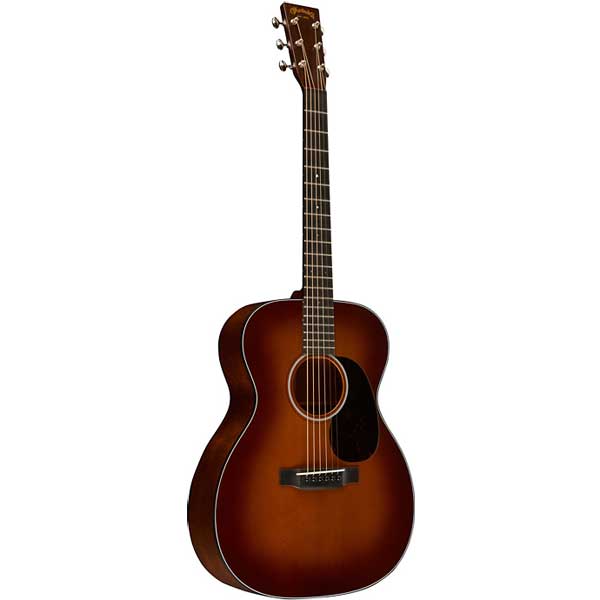
| Estimated Price | $5,300 |
| Body Style | Orchestra Model |
| Top | VTS Solid Adirondack Spruce |
| Back and Sides | Solid Genuine Mahogany |
| Neck | Mahogany |
| Finish | Gloss |
| Body Bracing | Standard ”X” Scalloped Bracing (Authentic Style) – Circa 1933 |
| Fret Count | 20 |
| Country of Origin | USA |
My Review: While high-end Martins are truly something special and the best that the company has to offer, their pre-war guitars are the stuff of legend, which is why the 1933 OM-18 is such a stunning piece of gear, which is a detailed recreation of those old Martins. And we aren’t just talking looks either. The entire construction process has been replicated, including the use of hide glue. The bracing has also been replicated and is exactly the same as it is on vintage pre-war Martins. The VTS in the name stands for Vintage Tone System, which is Martin’s name for the torrefaction process. It gives the guitar not just that coveted vintage sound but looks as well, which are suitably simple.
It features a solid Adirondack spruce top with solid genuine mahogany back and sides, along with a mahogany neck. The combination of these tonewoods makes for a guitar that has really beautiful highs and lows, with a midrange that projects extremely well. One of the things that might take some getting used to is the neck, which has a V shape. For more experienced players, this type of neck provides great support from the fretting hand. This acoustic guitar is not only extremely playable, but it’s also very light, which is the result of the torrefaction process. The only thing that we don’t like about this guitar is its price, but for this sort of craftsmanship, it couldn’t have been lower.
Who Will Use This Most: Those with deeper pockets, as well as fans of vintage instruments. They won’t be able to resist owning the closest thing to a pre-war Martin.
Bottom Line: The Martin OM-18 is a wonderful guitar, which not only produces a stunning sound but also has a ton of that “X” factor that made you pick up a guitar in the first place.

14. Martin HD-28 Standard Dreadnought Acoustic Guitar Aged Toner
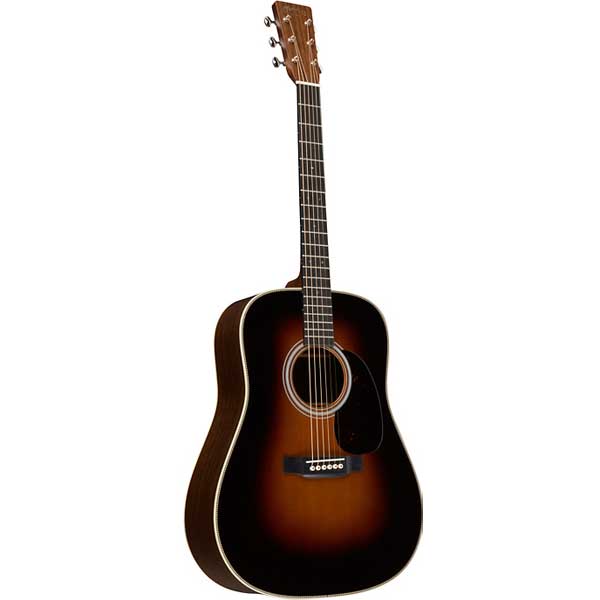
| Estimated Price | $3,400 |
| Body Style | Dreadnought |
| Top | Sitka Spruce |
| Back and Sides | Solid East Indian Rosewood |
| Neck | Mahogany |
| Finish | Gloss Nitrocellulose |
| Body Bracing | 5/16 Forward-Shifted, Scalloped X Bracing |
| Fret Count | 20 |
| Country of Origin | USA |
My Review: The Martin HD-28 and the D-28 are very, very similar, especially when it comes to measurements and proportions. Even by just glancing at them, they look pretty much the same. Seemingly, the only difference is the ‘H’ in the name, which stands for herringbone. And this is where things start to make sense. The HD-28 has herringbone binding, which reflects Martin’s intention to produce a more vintage version of the D-28, keeping all the good stuff, but adding the qualities shared by Martin guitars from the ‘30s and ‘40s. Adding to this vintage look is the tortoiseshell patterned pickguard, as well as more complex inlays. The HD-28 also has a beautiful aging toner finish.
In terms of sound, the combination of the solid Sitka spruce top and solid East Indian rosewood back and sides produces a sound that is rich and warm, deep on the low end and shimmering on the high end. We also love how smooth the mid-tones are. It’s basically a better version of the D-28, and that guitar is sheer perfection, which should tell you how good the HD-28 really is. Its tone is just incredible, whether you are flatpicking, fingerpicking, or strumming away on it, playing huge chords. In case you decide to buy this acoustic guitar, you aren’t likely to pick up anything else afterward for the rest of your life.
Who Will Use This Most: Professionals and connoisseurs who are looking for absolute perfection in terms of sound, build quality, as well as pedigree. Ideal for just about any setting, music genre, and playing style.
Bottom Line: The Martin HD-28 is an improved version of the already brilliant D-28, which adds some vintage details, as well as materials, to the original.

15. Taylor 414ce-R V-Class Grand Auditorium Acoustic-Electric Guitar Natural
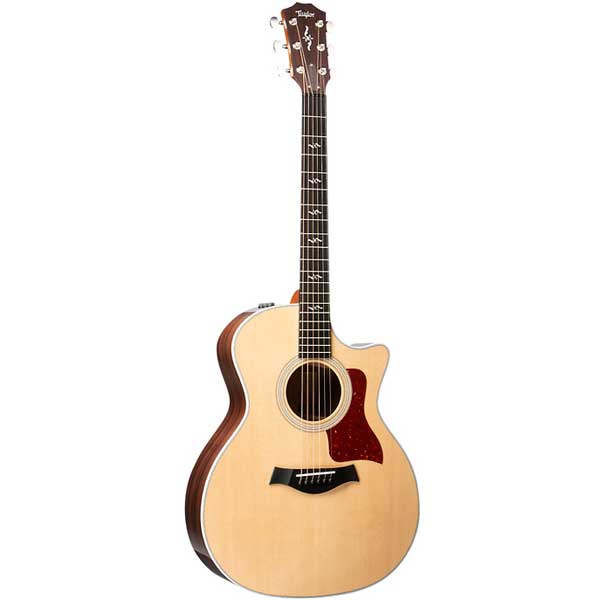
| Estimated Price | $2,800 |
| Body Style | Grand Auditorium with Venetian Cutaway |
| Top | Solid Sitka Spruce |
| Back and Sides | Solid Indian Rosewood |
| Neck | Tropical Mahogany |
| Finish | Gloss |
| Body Bracing | Taylor V-Class Bracing with Relief Rout |
| Fret Count | 20 |
| Country of Origin | USA |
My Review: The Taylor 414ce has been around for a while, and it’s one of the most popular models in the Taylor range of acoustic guitars. And it’s easy to see why, because this guitar sounds great and is superbly playable, like all Taylors. It’s especially brilliant in a live environment, not just because it has a built-in preamp, but also because it’s very resonant and responsive, and has that bright, signature Taylor sound we all know and love. The reason why it resonates and projects so well is because of its revolutionary V-Class bracing, which we have talked about on this list.
The top is made out of a solid Stika spruce top, with a really nice grain. The back and sides are made out of Indian rosewood, but there is also a version that features an ovangkol body, which has a very striking appearance and tonal qualities similar to that of rosewood. Other materials include ebony, which is used for the fretboard and the bridge, and Micarta, which can be found on the saddle. We all found the graphite nut to be a nice touch. Even though this guitar sounds great no matter what you play on it, we are confident in saying that it sounds at its best when it’s used for strumming.
Who Will Use This Most: The 414ce is ideal for any gigging musician, especially in a band environment where one needs an acoustic that is able to project really well. Also, it’s perfect for rock musicians, who like to switch between acoustic and electric during concerts.
Bottom Line: The Taylor 414ce V-Class acoustic guitar, as is the case with all high-end Taylors, is a superbly crafted instrument that sounds great and is really playable, and especially suitable for loud rock bands.

16. Taylor Guitars 914ce V-Class Grand Auditorium Acoustic-Electric Guitar
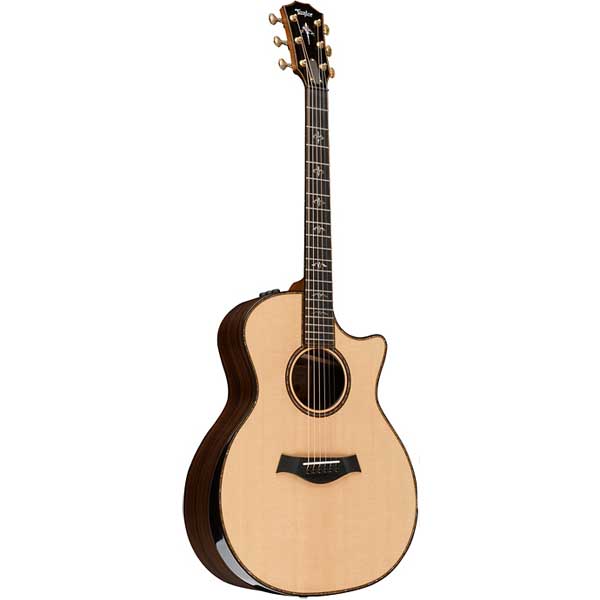
| Estimated Price | $5,500 |
| Body Style | Grand Auditorium with Venetian Cutaway |
| Top | Solid Sitka Spruce |
| Back and Sides | Solid Indian Rosewood |
| Neck | Tropical Mahogany with Ebony Backstrap |
| Finish | Gloss 3.5 |
| Body Bracing | Taylor V-Class Bracing with Relief Rout |
| Fret Count | 20 |
| Country of Origin | USA |
My Review: Yes, that’s another Taylor acoustic guitar on our list, not just because we lack imagination, but because Taylors are just so good at making high-end acoustics. Apart from Martin, there is no brand out there that comes even close. The 914ce, like most models in the line-up, features Taylor’s patented V-Class bracing which is designed to improve intonation and projection. What we have said about the previous Taylor models listed here applies to the 914ce, only everything is even more improved. The Grand Auditorium body features a solid Sitka spruce top, with solid rosewood back and sides, which give it that familiar Taylor sound.
While the attention to detail on Taylor guitars is always stunning, they have taken it to a whole new level here, with clever touches, such as the smooth armrest, which will be welcomed by gigging musicians, and the Ascension inlays. When it comes to sound, the 914ce delivers in a big way, both in terms of range and loudness. It’s hard to imagine any kind of playing style this guitar wouldn’t be perfect for. And, just like all high-end Taylors, this one also has a built-in preamp system, allowing you to play this guitar in any kind of live setting, which is where it belongs.
Who Will Use This Most: When you consider that this is one of the most expensive acoustic guitars on our list, the 914ce will remain a dream for many, but professional musicians and bands will surely have one of these in their collections.
Bottom Line: The Taylor 914ce is the absolute Taylor has to offer, which basically means that it’s one of the best guitars you can currently buy. Despite the astronomical price tag, it’s worth every penny.

17. Martin D-18E Dreadnought Acoustic Electric Guitar
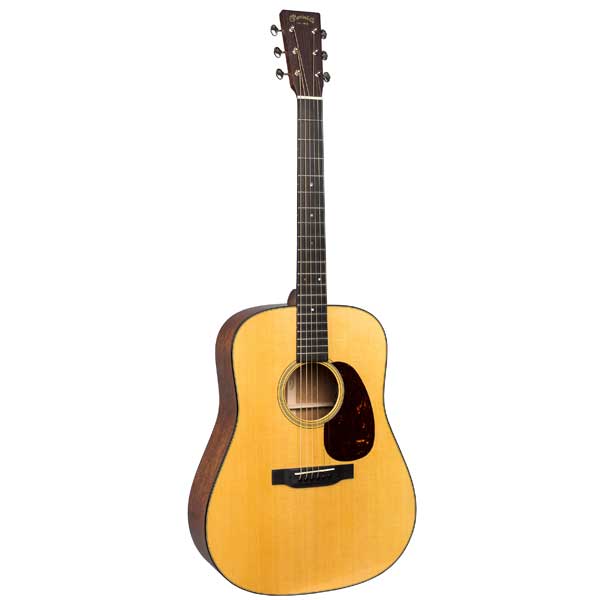
| Estimated Price | $4,200 |
| Body Style | Dreadnought |
| Top | Solid Sitka Spruce |
| Back and Sides | Solid Genuine Mahogany |
| Neck | Mahogany |
| Finish | Gloss |
| Body Bracing | Forward Shifted Pattern Sitka Spruce Scalloped X-Bracing |
| Fret Count | 20 |
| Country of Origin | USA |
My Review: We have started our list with a Martin, and we are suitably ending in with a Martin, only this time we are looking at the D-18E Retro, which has been built with the intention of mimicking the Martin dreadnought classics used by the likes of Elvis Presley, Bob Dylan, Johnny Cash, Noel Gallagher, and Kurt Cobain, just to name a few. The Martin D-18E is every bit as classic as those guitars Martin has built in the past, and its looks follow suit. You will find the tortoiseshell-color binding, ebony 30s-style bridge, old-school abalone inlays, and vintage tuners. It looks great.
In terms of sound, the D-18E retro has a clean and bright tone with plenty of projection and sustain, with a very pronounced midrange. The scalloped X-bracing pattern allows this guitar to resonate freely. As with all high-end acoustic guitars, you can expect them to only get better with age, which has us curious since the D-18E Retro already sounds like a well-played-in instrument.
Who Will Use This Most: The D-18E Retro, given its pedigree, is a natural acoustic guitar of choice for rock musicians, although it will sound equally well in all genres. Also, those who love the vintage sound, but don’t want to spend five figures on an actual vintage Martin, will absolutely love this.
Bottom Line: The Martin D-18E Retro is a fantastic guitar and an absolute must-buy. We love just about everything about it, including the vintage details, and we cannot recommend it enough.

Buyer’s Guide
In this section, we are going to skip over the guitar basics, such as different guitar types or body styles, and focus on why high-end acoustic guitars are so expensive, as well as what you’ll need to know when you decide to purchase one. Even though it would be almost impossible to find a flaw with any of the guitars we have reviewed above, there are still some pretty huge price differences among them as well, so you want to make the most out of your budget, even at such a steep price bracket.
You also need to keep in mind that these acoustic guitars, provided that you take proper care of them, are lifelong companions and will only sound better with age. That being said, let’s take a look at what makes these premium acoustic guitars so good (and so expensive):
Solid Wood Vs. Laminate
The first difference between high-end acoustic guitars and cheap/mid-range guitars is the quality of the materials used to build them. In this case, we are talking about the kind of wood they’re made of.
Laminate acoustic guitars are made from laminated wood. Laminate is composed of thin sheets of wood that are glued together, which allows for mass production and lower retail price of acoustic guitars. However, laminate guitars do not sound as good as solid wood guitars, because laminate woods don’t resonate freely as solid woods, and the tone itself is not as pleasant or as full-bodied.
However, this doesn’t mean that laminate guitars sound bad, period, but they are inferior when compared to acoustic guitars which are made from solid wood, or which at least have a solid top. Do laminate guitars have any advantages? In some ways, yes. Laminate wood is more resistant to humidity and temperature changes. This makes them better for musicians who view the guitar as a workhorse and aren’t interested in storing them properly.
Solid wood acoustic guitars, just like their name indicates, are guitars whose top, back, and sides are made out of single pieces of wood, as opposed to thin sheets of wood that are glued together. Solid woods are responsible for the guitar’s tone, which is a quality that cannot be easily quantified. Solid wood also sounds better with age, since it undergoes changes on a molecular level. As hemicellulose evaporates from the wood over time, it changes other characteristics of the guitar, such as weight, making the guitar lighter, as well as resistant to temperature and humidity. That, in turn, changes the guitar’s frequency response and makes the sound more airy, resonant, and clear, throughout the entire range. All this talk about solid wood brings us to our next point: tonewoods.
Tonewoods
This is a highly controversial subject among guitar aficionados since some claim it’s nothing more than a myth, while others swear by particular types of tonewood. We still think that it’s important to provide you with all the available information, and then you can make a decision for yourself. Also note that acoustic guitars are usually built using at least two different types of tonewood, such as spruce for the body, mahogany for back and sides, and rosewood for the fretboard, for example. With that in mind, here are some of the most popular types of tonewoods you will come across on high-end acoustic guitars:
Sitka Spruce: this is probably the most common tonewood as far as guitar top is concerned. And it’s popular for a good reason because Sitka spruce is pleasingly resonant throughout the entire dynamic range of the guitar. It produced a bright, powerful, and clear sound, making it suitable for both strumming and lead parts. It’s also very sturdy and lightweight.
Engelmann Spruce: very similar to Sitka spruce, although it tends to be more responsive when played with a softer touch, making it more suitable for more delicate guitar parts or fingerpicking. If your playing involves strumming loud, booming chords, you would be better off with a guitar that has Sitka spruce top.
Adirondack Spruce: Also known as Red spruce, this is a highly sought-after type of tonewood. It’s harder to come by nowadays since it has been over-harvested in the past, which is why you are more likely to find it on vintage acoustic guitars. In terms of sound, Adirondack spruce produces a loud, full, and rich tone that is superior to those of Sitka and Engelmann.
Mahogany: Mahogany is one of the common tonewoods of choice for the back and sides of the guitar. Because spruce tops tend to sound more lively and bright, mahogany is used for the rest of the body because it produces very pleasant bass and mid-range frequencies. Acoustic guitars which feature a mahogany top as well have a darker, warmer sound, which makes them ideal for rhythm playing as opposed to fingerpicking.
Cedar: This is the second most-used tonewood for guitar tops, right behind spruce. However, because cedar is lens dense, its sound is less bright, but full of dark tones. It’s also known for its rich overtones, which makes it ideal for fingerpicking. It’s also not as loud as spruce and doesn’t respond as well to a heavier attack on the strings.
Rosewood: This type of tonewood is known for its sustain, as well as great frequency response throughout the entire range. Unfortunately, it’s rarely used for guitar bodies, due to various restrictions which were put into place to prevent overharvesting. However, rosewood is almost irreplaceable as a fretboard wood, due to its properties. It’s very smooth, resistant to wear and staining, and it is naturally oily, so it doesn’t require any additional finishing.
Maple: This is a very dense tonewood that is well-known for its bright, loud, and flat sound. This is why you will often find maple on jumbo guitars to counteract their overabundant low end. It’s also more commonly found on fretboards of electric guitars since darker woods tend to look more aesthetically pleasing.
Koa: You will often find this tonewood on ukuleles. Not many guitars are built using this type of wood, mainly due to how expensive it is. Koa is also highly sought-after because of its looks, which features a very distinctive grain. In terms of sound, Koa is also praised for its really bright sound that gets warmer with age, which makes it great for fingerpicking.
Walnut: In terms of durability, walnut is right up there with rosewood, which is why it’s mainly used for fretboards on electric guitars. Again, because acoustic guitars tend to look more pleasing with darker fretboards, walnut is a rare occurrence. However, it really stands out when used for the back and sides, and when it comes to sound, it’s comparable to Koa. Unlike Koa, though, it’s much more attainable and easier to work with.
As you can see, one tonewood is not necessarily better than the other, and in most cases, the sound of your high-end acoustic guitar will be the result of several of these tonewoods combined.
Branding
Another factor that plays a big role in both the quality and price of high-end acoustic guitars is branding. We are all familiar with guitar manufacturers like Taylor, Martin, Gibson, Fender, PRS, or Yamaha. They are practically household names among the people that have even the slightest interest in music. Some brands have been around for over a century, and have built a stellar reputation and loyal following. Even though they offer quality guitars, they are able to price their products higher on brand name alone, which is often the case with Apple in the tech world.
Apart from offering a premium product, larger brands also work with famous artists, creating their own signature guitars for them, which are often sold for hundreds or even thousands of dollars more than the equivalent non-signature acoustic guitars.
Manufacturing Location and Labor Cost
Manufacturing location and labor costs are probably two of the biggest factors which contribute to the price of premium acoustic guitars. Most high-end acoustics are made in the US, where the cost of labor is very high, as well as build quality, simply because American workers have been at it for longer and are more skilled at building guitars. Also, because these high-end guitars are usually built by hand, the attention to detail is superior as opposed to guitars which are built by the hundreds on a factory line.
In order to make their guitars more affordable, large guitar manufacturers outsource their production to countries like China, Indonesia, or South Korea. Because the cost of labor is much lower in these countries, manufacturers are able to make more of these guitars and sell them at a lower price. While this does not necessarily equal an inferior product, it’s difficult to achieve consistent quality control over such huge production volumes.
Build Quality and Attention to Detail
This ties right into our previous point. Because high-end acoustic guitars are made by hand in small series, they are inspected for every last detail. All of these add up and make a huge difference in the end. For example, things like rough fret edges, inconsistent finish, or loose knobs and dials are not uncommon on cheap guitars. Premium acoustic guitars are nearly always perfect when it comes to these parameters, and they usually come already set up by a professional.
Apart from sounding great and playing well, high-end acoustic guitars are a thing to behold. It’s not uncommon to see luthiers pay attention to every single detail, such as the use of abalone for fretboard inlays or mother-of-pearl for the rosette. Other stuff, such as binding, not only gives the guitar a premium look, but it also makes it more sound structurally. Also, it’s hard to ignore an acoustic guitar that has a beautiful finish that complements the natural beauty of the tonewood, as well as provides a layer of protection from the elements and everyday use.
Other Considerations
When buying a premium acoustic guitar, you should also look deep beneath the surface. One of the things you might want in a high-end acoustic is a two-way adjustable truss rod, which enables you to adjust the guitar’s action. You can also use it to position the neck just the way you like it because high-end acoustic guitars should feel just as good as they sound. Also, if possible, you should always go for a guitar that has a replaceable bridge, which allows you to change it in order to practice different types of music. Last, but not least, high-end acoustic guitars should have die-cast or sealed tuners, preferably those with a 14:1 tuning ratio. If you are looking at a premium guitar that has plastic tuners, you should probably keep looking.
We hope that this extensive buyer’s guide, as well as guitar reviews, will help you make an informed choice when purchasing a premium acoustic guitar. Good luck!

My name is Chris and I’ve had a passion for music and guitars for as long as I can remember. I started this website with some of my friends who are musicians, music teachers, gear heads, and music enthusiasts so we could provide high-quality guitar and music-related content.
I’ve been playing guitar since I was 13 years old and am an avid collector. Amps, pedals, guitars, bass, drums, microphones, studio, and recording gear, I love it all.
I was born and raised in Western Pennsylvania. My background is in Electrical Engineering, earning a Bachelor’s degree from Youngstown State University. With my engineering experience, I’ve developed as a designer of guitar amplifiers and effects. A true passion of mine, I’ve designed, built, and repaired a wide range of guitar amps and electronics. Here at the Guitar Lobby, our aim is to share our passion for Music and gear with the rest of the music community.
